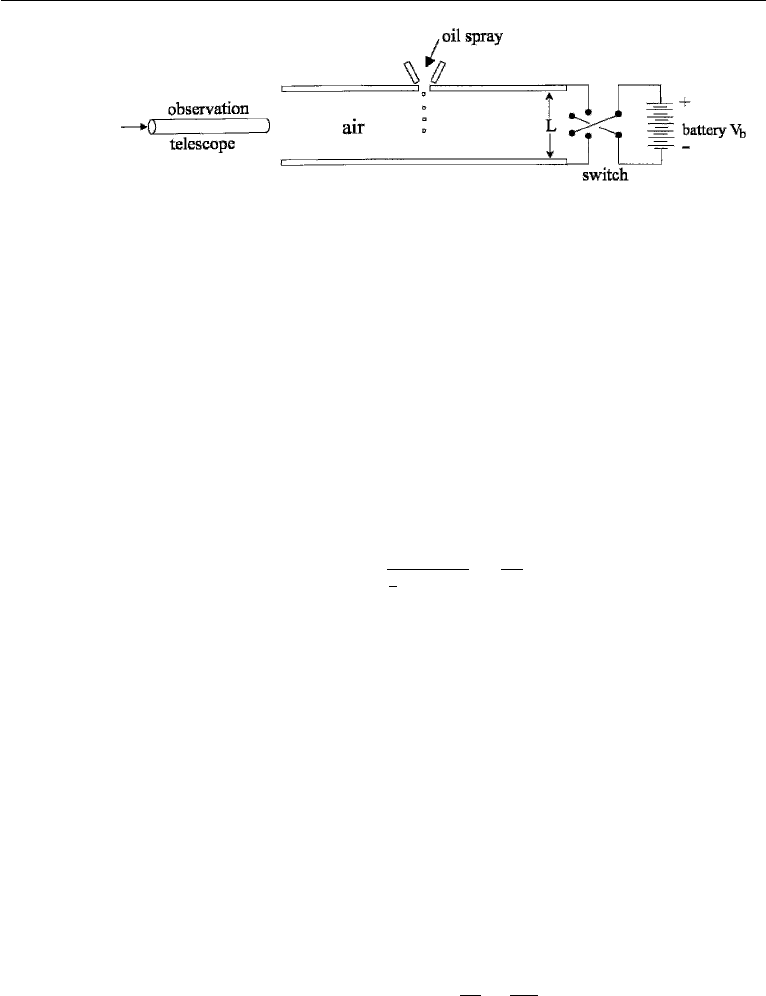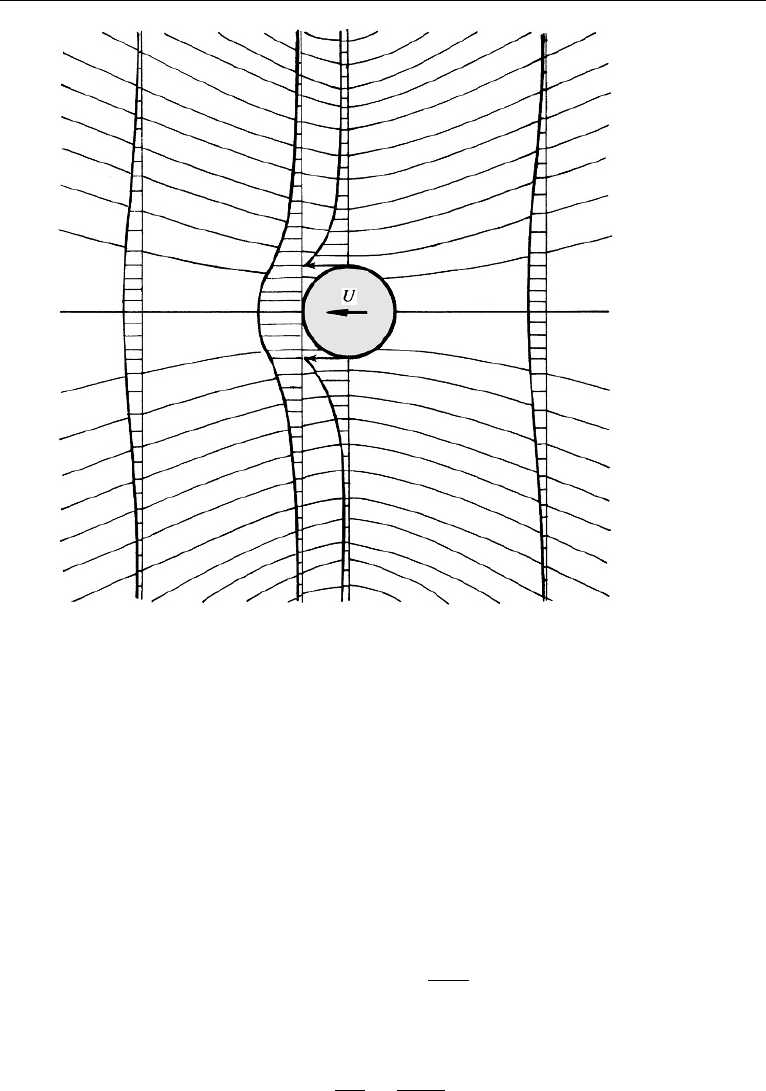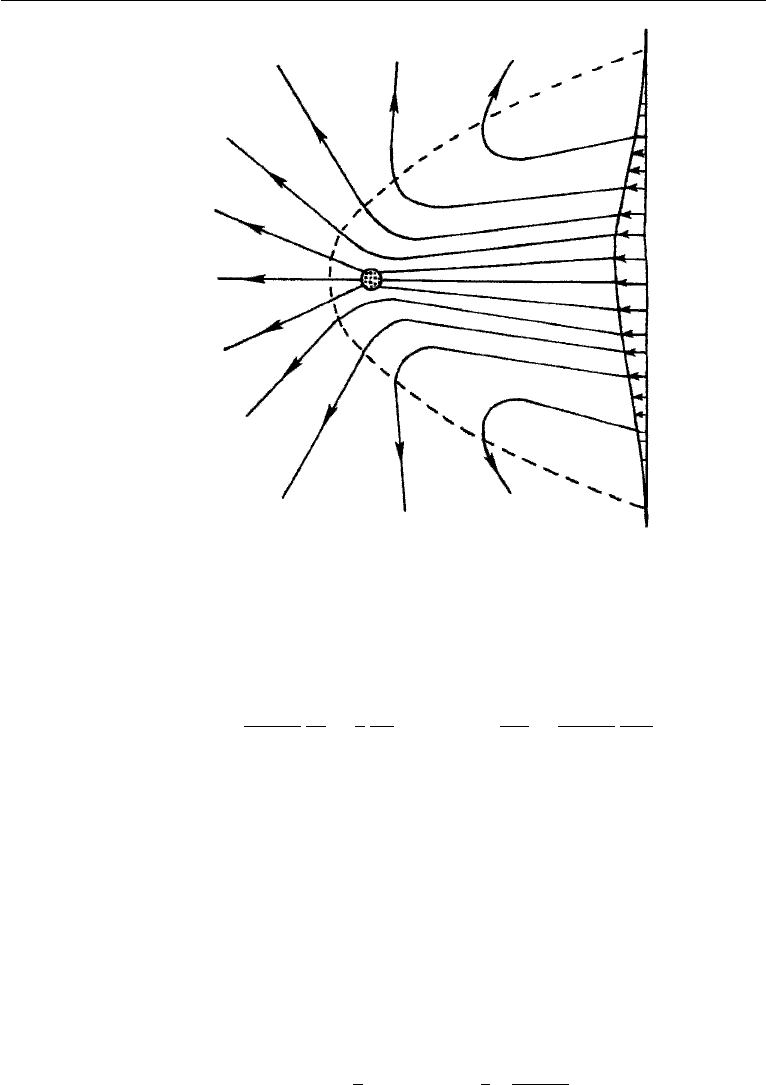Cohen I.M., Kundu P.K. Fluid Mechanics
Подождите немного. Документ загружается.


322 Laminar Flow
The proper scales depend on the nature of the flow and are obtained by equating
the terms that are most important in the flow field. For a high Reynolds number
flow, the dominant terms are the inertia and pressure forces. This suggests the scaling
(9.59), resulting in the nondimensional equation (9.60) in which the small parameter
multiplies the subdominant term (except in boundary layers). In contrast, the dominant
terms for a low Reynolds number flow are the pressure and viscous forces. This
suggests the scaling (9.61), resulting in the nondimensional equation (9.62) in which
the small parameter multiplies the subdominant term.
12. Creeping Flow around a Sphere
A solution for the creeping flow around a sphere was first given by Stokes in 1851.
Consider the low Reynolds number flow around a sphere of radius a placed in a uni-
form stream U (Figure 9.14). The problem is axisymmetric, that is, the flow patterns
are identical in all planes parallel to U and passing through the center of the sphere.
Since Re → 0, as a first approximation we may neglect the inertia forces altogether
and solve the equation
∇p = µ∇
2
u
∗
.
Figure 9.14 Creeping flow over a sphere. The upper panel shows the viscous stress components at the
surface. The lower panel shows the pressure distribution in an axial (ϕ = const.) plane.

12. Creeping Flow around a Sphere 323
We can form a vorticity equation by taking the curl of the preceding equation,
obtaining
0 =∇
2
ω
∗
.
Here, we have used the fact that the curl of a gradient is zero, and that the order of the
operators curl and ∇
2
can be interchanged. (The reader may verify this using indicial
notation.) The only component of vorticity in this axisymmetric problem is ω
ϕ
, the
component perpendicular to ϕ = const. planes in Figure 9.14, and is given by
ω
ϕ
=
1
r
∂(ru
θ
)
∂r
−
∂u
r
∂θ
.
In axisymmetric flows we can define a streamfunction ψ given in Section 6.18. In
spherical coordinates, it is defined as u =−∇ϕ × ∇ψ, (6.74) so
u
r
≡
1
r
2
sin θ
∂ψ
∂θ
u
θ
≡−
1
r sin θ
∂ψ
∂r
.
In terms of the streamfunction, the vorticity becomes
ω
ϕ
=−
1
r
1
sin θ
∂
2
ψ
∂r
2
+
1
r
2
∂
∂θ
1
sin θ
∂ψ
∂θ
.
The governing equation is
∇
2
ω
ϕ
= 0
∗
.
Combining the last two equations, we obtain
∂
2
∂r
2
+
sin θ
r
2
∂
∂θ
1
sin θ
∂
∂θ
2
ψ = 0. (9.64)
The boundary conditions on the preceding equation are
ψ(a,θ) = 0 [u
r
= 0 at surface], (9.65)
∂ψ/∂r(a,θ) = 0 [u
θ
= 0 at surface], (9.66)
ψ(∞,θ) =
1
2
Ur
2
sin
2
θ [uniform flow at ∞]. (9.67)
The last condition follows from the fact that the stream function for a uniform flow
is (1/2)U r
2
sin
2
θ in spherical coordinates (see equation (6.76)).
* In spherical polar coordinates, the operator in the footnoted equations is actually −∇ × ∇ ×
(−curl curl
), which is different from the Laplace operator defined in Appendix B. Eq. (9.64) is the
square of the operator, and not the biharmonic.

324 Laminar Flow
The upstream condition (9.67) suggests a separable solution of the form
ψ = f(r)sin
2
θ.
Substitution of this into the governing equation (9.64) gives
f
iv
−
4f
r
2
+
8f
r
3
−
8f
r
4
= 0,
whose solution is
f = Ar
4
+ Br
2
+ Cr +
D
r
.
The upstream boundary condition (9.67) requires that A = 0 and B = U/2. The
surface boundary conditions then give C =−3 Ua/4 and D = Ua
3
/4. The solution
then reduces to
ψ = Ur
2
sin
2
θ
1
2
−
3a
4r
+
a
3
4r
3
. (9.68)
The velocity components can then be found as
u
r
=
1
r
2
sin θ
∂ψ
∂θ
= U cos θ
1 −
3a
2r
+
a
3
2r
3
,
u
θ
=−
1
r sin θ
∂ψ
∂r
=−U sin θ
1 −
3a
4r
−
a
3
4r
3
.
(9.69)
The pressure can be found by integrating the momentum equation ∇p = µ∇
2
u. The
result is
p =−
3aµU cos θ
2r
2
+ p
∞
(9.70)
The pressure distribution is sketched in Figure 9.14. The pressure is maximum at
the forward stagnation point where it equals 3µU/2a, and it is minimum at the rear
stagnation point where it equals −3µU/2a.
Let us determine the drag force D on the sphere. One way to do this is to apply
the principle of mechanical energy balance over the entire flow field given in equa-
tion (4.63). This requires
DU =
φdV,
which states that the work done by the sphere equals the viscous dissipation over the
entire flow; here, φ is the viscous dissipation per unit volume. A more direct way to
determine the drag is to integrate the stress over the surface of the sphere. The force
per unit area normal to a surface, whose outward unit normal is n is
F
i
= τ
ij
n
j
=[−pδ
ij
+ σ
ij
]n
j
=−pn
i
+ σ
ij
n
j
,

12. Creeping Flow around a Sphere 325
where τ
ij
is the total stress tensor, and σ
ij
is the viscous stress tensor. The component
of the drag force per unit area in the direction of the uniform stream is therefore
[−p cos θ + σ
rr
cos θ − σ
rθ
sin θ]
r=a
, (9.71)
which can be understood from Figure 9.14. The viscous stress components are
σ
rr
= 2µ
∂u
r
∂r
= 2µU cos θ
3a
2r
2
−
3a
3
2r
4
,
σ
rθ
= µ
r
∂
∂r
u
θ
r
+
1
r
∂u
r
∂θ
=−
3µUa
3
2r
4
sin θ,
(9.72)
so that equation (9.71) becomes
3µU
2a
cos
2
θ +0 +
3µU
2a
sin
2
θ =
3µU
2a
.
The drag force is obtained by multiplying this by the surface area 4πa
2
of the sphere,
which gives
D = 6πµaU, (9.73)
of which one-third is pressure drag and two-thirds is skin friction drag. It follows
that the resistance in a creeping flow is proportional to the velocity; this is known as
Stokes’ law of resistance.
In a well-known experiment to measure the charge of an electron, Millikan used
equation (9.73) to estimate the radius of an oil droplet falling through air. Suppose
ρ
is the density of a spherical falling particle and ρ is the density of the surrounding
fluid. Then the effective weight of the sphere is 4πa
3
g(ρ
− ρ)/3, which is the weight
of the sphere minus the weight of the displaced fluid. The falling body is said to reach
the “terminal velocity” when it no longer accelerates, at which point the viscous drag
equals the effective weight. Then
4
3
πa
3
g(ρ
− ρ) = 6πµaU,
from which the radius a can be estimated.
Millikan was able to deduce the charge on an electron making use of Stokes’ drag
formula by the following experiment. Two horizontal parallel plates can be charged
by a battery (see Fig. 9.15). Oil is sprayed through a very fine hole in the upper plate
and develops static charge (+) by losing a few (n) electrons in passing through the
small hole. If the plates are charged, then an electric force neE will act on each of
the drops. Now n is not known but E =−V
b
/L, where V
b
is the battery voltage
and L is the gap between the plates, provided that the charge density in the gap is
very low. With the plates uncharged, measurement of the downward terminal velocity
allowed the radius of a drop to be calculated assuming that the viscosity of the drop
is much larger than the viscosity of the air. The switch is thrown to charge the upper

326 Laminar Flow
Figure 9.15 Millikan oil drop experiment.
plate negatively. The same droplet then reverses direction and is forced upwards. It
quickly achieves its terminal velocity U
u
by virtue of the balance of upward forces
(electric + buoyancy) and downward forces (weight + drag). This gives
6πµU
u
a + (4/3)π a
3
g(ρ
− ρ) = neE,
where U
u
is measured by the observation telescope and the radius of the particle is
now known. The data then allow for the calculation of ne.Asn must be an integer,
data from many droplets may be differenced to identify the minimum difference that
must be e, the charge of a single electron.
The drag coefficient, defined as the drag force nondimensionalized by ρU
2
/2
and the projected area πa
2
,is
C
D
≡
D
1
2
ρU
2
πa
2
=
24
Re
, (9.74)
where Re = 2aU/ν is the Reynolds number based on the diameter of the sphere.
In Chapter 8, Section 5 it was shown that dimensional considerations alone require
that C
D
should be inversely proportional to Re for creeping motions. To repeat the
argument, the drag force in a “massless” fluid (that is, Re 1) can only have the
dependence
D = f(µ,U,a).
The preceding relation involves four variables and the three basic dimensions of mass,
length, and time. Therefore, only one nondimensional parameter, namely, D/µU a,
can be formed. As there is no second nondimensional parameter for it to depend on,
D/µU a must be a constant. This leads to C
D
∝ 1/Re.
The flow pattern in a reference frame fixed to the fluid at infinity can be found
by superposing a uniform velocity U to the left. This cancels out the first term in
equation (9.68), giving
ψ = Ur
2
sin
2
θ
−
3a
4r
+
a
3
4r
3
,
which gives the streamline pattern as seen by an observer if the sphere is dragged
in front of him from right to left (Figure 9.16). The pattern is symmetric between
the upstream and the downstream directions, which is a result of the linearity of the

13. Nonuniformity of Stokes’ Solution and Oseen’s Improvement 327
Figure 9.16 Streamlines and velocity distributions in Stokes’ solution of creeping flow due to a moving
sphere. Note the upstream and downstream symmetry, which is a result of complete neglect of nonlinearity.
governing equation (9.63); reversing the direction of the free-stream velocity merely
changes u to −u and p to −p. The flow therefore does not have a “wake” behind the
sphere.
13. Nonuniformity of Stokes’ Solution and
Oseen’s Improvement
The Stokes solution for a sphere is not valid at large distances from the body because
the advective terms are not negligible compared to the viscous terms at these distances.
From equation (9.72), the largest viscous term is of the order
viscous force/volume = stress gradient ∼
µUa
r
3
as r →∞,
while from equation (9.69) the largest inertia force is
inertia force/volume ∼ ρu
r
∂u
θ
∂r
∼
ρU
2
a
r
2
as r →∞.

328 Laminar Flow
Therefore,
inertia force
viscous force
∼
ρUa
µ
r
a
=
r
a
as r →∞.
This shows that the inertia forces are not negligible for distances larger than r/a ∼
1/Re. At sufficiently large distances, no matter how small Re may be, the neglected
terms become arbitrarily large.
Solutions of problems involving a small parameter can be developed in terms
of the perturbation series in which the higher-order terms act as corrections on the
lower-order terms. Perturbation expansions are discussed briefly in the following
chapter. If we regard the Stokes solution as the first term of a series expansion in the
small parameter Re, then the expansion is “nonuniform” because it breaks down at
infinity. If we tried to calculate the next term (to order Re) of the perturbation series,
we would find that the velocity corresponding to the higher-order term becomes
unbounded at infinity.
The situation becomes worse for two-dimensional objects such as the circular
cylinder. In this case, the Stokes balance ∇ p = µ∇
2
u has no solution at all that can
satisfy the uniform flow boundary condition at infinity. From this, Stokes concluded
that steady, slow flows around cylinders cannot exist in nature. It has now been realized
that the nonexistence of a first approximation of the Stokes flow around a cylinder is
due to the singular nature of low Reynolds number flows in which there is a region
of nonuniformity at infinity. The nonexistence of the second approximation for flow
around a sphere is due to the same reason. In a different (and more familiar) class
of singular perturbation problems, the region of nonuniformity is a thin layer (the
“boundary layer”) near the surface of an object. This is the class of flows with Re →
∞, that will be discussed in the next chapter. For these high Reynolds number flows
the small parameter 1/Re multiplies the highest-order derivative in the governing
equations, so that the solution with 1/Re identically set to zero cannot satisfy all
the boundary conditions. In low Reynolds number flows this classic symptom of
the loss of the highest derivative is absent, but it is a singular perturbation problem
nevertheless.
In 1910 Oseen provided an improvement to Stokes’ solution by partly accounting
for the inertia terms at large distances. He made the substitutions
u = U + u
v = v
w = w
,
where (u
,v
,w
) are the Cartesian components of the perturbation velocity, and are
small at large distances. Substituting these, the advection term of the x-momentum
equation becomes
u
∂u
∂x
+ v
∂u
∂y
+ w
∂u
∂z
= U
∂u
∂x
+
u
∂u
∂x
+ v
∂u
∂y
+ w
∂u
∂z
.
Neglecting the quadratic terms, the equation of motion becomes
ρU
∂u
i
∂x
=−
∂p
∂x
i
+ µ∇
2
u
i
,

13. Nonuniformity of Stokes’ Solution and Oseen’s Improvement 329
where u
i
represents u
, v
,orw
. This is called Oseen’s equation, and the approxima-
tion involved is called Oseen’s approximation. In essence, the Oseen approximation
linearizes the advective term u
•
∇u by U(∂u/∂x), whereas the Stokes approximation
drops advection altogether. Near the body both approximations have the same order
of accuracy. However, the Oseen approximation is better in the far field where the
velocity is only slightly different than U . The Oseen equations provide a lowest-order
solution that is uniformly valid everywhere in the flow field.
The boundary conditions for a moving sphere are
u
= v
= w
= 0 at infinity
u
=−U, v
= w
= 0 at surface.
The solution found by Oseen is
ψ
Ua
2
=
r
2
2a
2
+
a
4r
sin
2
θ −
3
Re
(1 + cos θ)
1 − exp
−
Re
4
r
a
(1 − cos θ)
,
(9.75)
where Re = 2aU/ν is the Reynolds number based on diameter. Near the surface
r/a ≈ 1, and a series expansion of the exponential term shows that Oseen’s solution
is identical to the Stokes solution (9.68) to the lowest order. The Oseen approximation
predicts that the drag coefficient is
C
D
=
24
Re
1 +
3
16
Re
,
which should be compared with the Stokes formula (9.74). Experimental results (see
Figure 10.22 in the next chapter) show that the Oseen and the Stokes formulas for
C
D
are both fairly accurate for Re < 5.
The streamlines corresponding to the Oseen solution (9.75) are shown in
Figure 9.17, where a uniform flow of U is added to the left so as to generate the
pattern of flow due to a sphere moving in front of a stationary observer. It is seen
that the flow is no longer symmetric, but has a wake where the streamlines are closer
together than in the Stokes flow. The velocities in the wake are larger than in front of
the sphere. Relative to the sphere, the flow is slower in the wake than in front of the
sphere.
In 1957, Oseen’s correction to Stokes’ solution was rationalized independently
by Kaplun and Proudman and Pearson in terms of matched asymptotic expansions.
Here, we will obtain only the first-order correction. The full vorticity equation is
∇×∇×ω = Re∇×(u × ω). (9.76)
In terms of the Stokes streamfunction ψ, equation (9.64) is generalized to
D
4
ψ = Re
1
r
2
∂(ψ,D
2
ψ)
∂(r,µ)
+
2
r
2
D
2
ψLψ
, (9.77)

330 Laminar Flow
Figure 9.17 Streamlines and velocity distribution in Oseen’s solution of creeping flow due to a moving
sphere. Note the upstream and downstream asymmetry, which is a result of partial accounting for advection
in the far field.
where ∂(ψ,D
2
ψ)/∂(r, µ) is shorthand notation for the Jacobian determinant with
those four elements, µ = cos θ , and the operators are
L =
µ
1 − µ
2
∂
∂r
+
1
r
∂
∂µ
,D
2
=
∂
2
∂r
2
+
1 − µ
2
r
2
∂
2
∂µ
2
.
We have seen that the right-hand side of equation (9.76) or (9.77) becomes of the
same order as the left-hand side when Re r/a ∼ 1orr/a ∼ 1/Re. We will define
the “inner region” as r/a 1/Re so that Stokes’ solution holds approximately. To
obtain a better approximation in the inner region, we will write
ψ(r,µ;Re) = ψ
0
(r, µ) + Re ψ
1
(r, µ) + o(Re), (9.78)
where the second correction “o(Re)” means that it tends to zero faster than Re in
the limit Re → 0. (See Chapter 10, Section 12. Here ψ is made dimensionless by
Ua
2
and Re = Ua/ν.) Substituting equation (9.78) into (9.77) and taking the limit
Re → 0, we obtain D
4
ψ
0
= 0 and recover Stokes’ result
ψ
0
=−
1
2
2r
2
− 3r +
1
r
µ
2
− 1
2
. (9.79)

13. Nonuniformity of Stokes’ Solution and Oseen’s Improvement 331
Subtracting this, dividing by Re and taking the limit Re → 0, we obtain
D
4
ψ
1
=
1
r
2
∂(ψ
0
,D
2
ψ
0
)
∂(r,µ)
+
2
r
2
D
2
ψ
0
Lψ
0
,
which reduces to
D
4
ψ
1
=
9
4
2
r
2
−
3
r
3
+
1
r
5
µ(µ
2
− 1), (9.80)
by using equation (9.79). This has the solution
ψ
1
= C
1
2r
2
− 3r +
1
r
µ
2
− 1
2
+
3
16
2r
2
− 3r + 1 −
1
r
+
1
r
2
µ(µ
2
− 1)
2
,
(9.81)
where C
1
is a constant of integration for the solution to the homogeneous equation
and is to be determined by matching with the outer region solution.
In the outer region rRe = ρ is finite. The lowest-order outer solution must be
uniform flow. Then we write the streamfuntion as
(ρ, θ;Re) =
1
2
ρ
2
Re
2
sin
2
θ +
1
Re
1
(ρ, θ ) + o
1
Re
.
Substituting in equation (9.77) and taking the limit Re → 0 yields
D
2
− cos θ
∂
∂ρ
+
sin θ
ρ
∂
∂θ
D
2
1
= 0, (9.82)
where the operator
D
2
= ∂
2
/∂ρ
2
+
sin θ
ρ
2
∂
∂θ
1
sin θ
∂
∂θ
.
The solution to equation (9.82) is found to be
1
(ρ, θ ) =−2C
2
(1 + cos θ)[1 − e
−ρ(1−cos θ)/2
],
where the constant of integration C
2
is determined by matching in the overlap region
between the inner and outer regions: 1 r 1/Re, Re ρ 1.
The matching gives C
2
= 3/4 and C
1
=−3/16. Using this in equation (9.81)
for the inner region solution, the O(Re) correction to the stream function (equa-
tion (9.81)) has been obtained, from which the velocity components, shear stress, and
pressure may be derived. Integrating over the surface of the sphere of radius = a,we
obtain the final result for the drag force
D = 6πµUa[1 + 3Ua/(8ν)],
which is consistent with Oseen’s result. Higher-order corrections were obtained by
Chester and Breach (1969).
